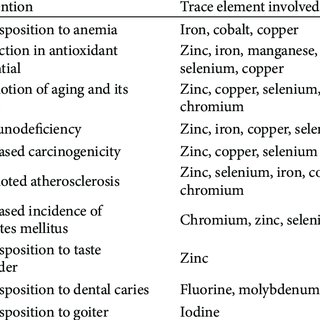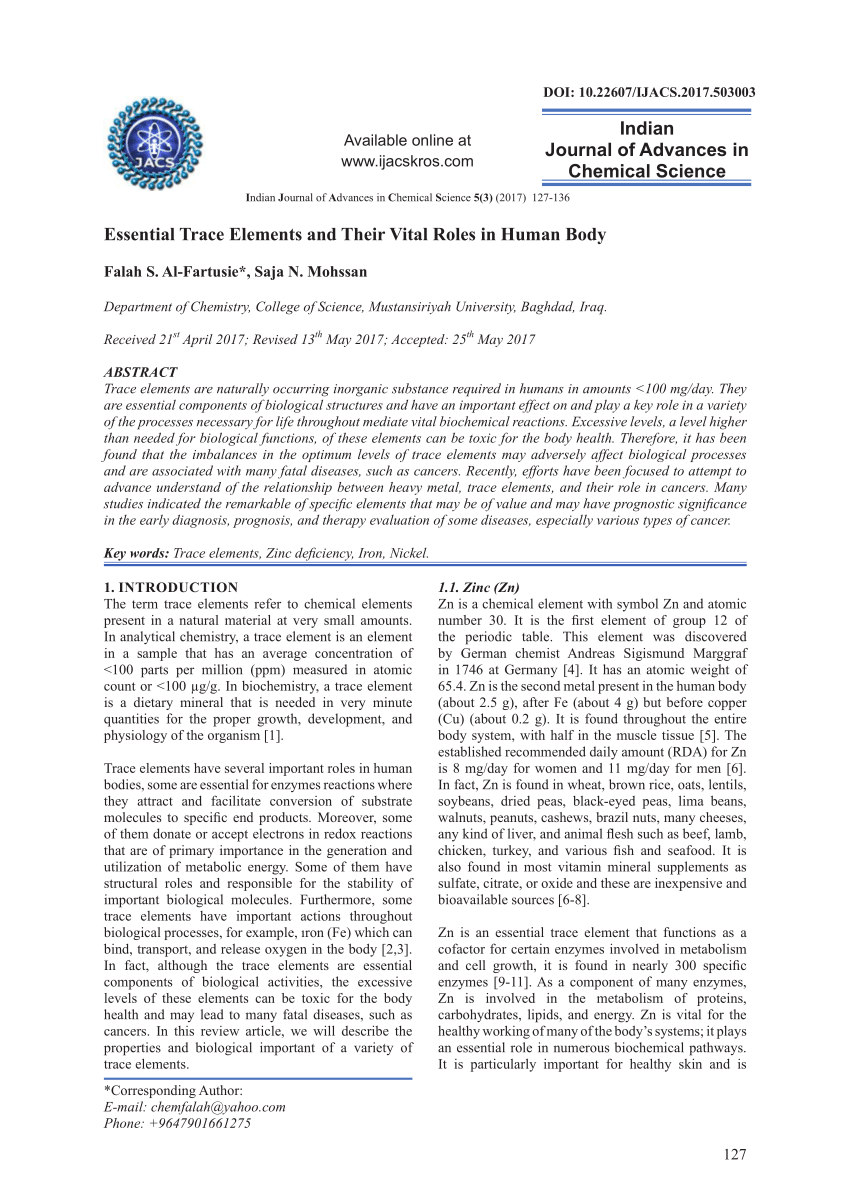
Role of trace elements in animals a review Human body requires certain essential elements in small quantities and their absence or excess may result in severe malfunctioning of the body and even death in extreme cases because these essential trace elements directly influence the metabolic and physiologic processes of the organism. Rapid urbanization and economic development have resulted in drastic changes in diets with developing
Essential trace elements in humans SpringerLink
Minerals and trace elements in food and diet. Essential trace elements are very important for healthy human diet. Also the stability of the chemi-cal composition is important for the support and regulation of vital functions. Variations in the con-tent of trace elements as micronutrientsmay be due to dysregulation of the body's interaction with the environment (Agadzhanjan, Skalny, 2001)., Minerals and trace elements in food and diet Mineral elements in food Definition: chemical elements contained in the • non-essential elements According to content According to significance Total amount of some elements in an adult human body 5-10 mg 10-20 mg 100-180 mg 1.4 g 0.8-2.5 g.
What are Trace Elements? 14 Examples The Trace elements Are bioelements present in all living beings, being chemical elements that can be found in almost any living particle. Within living beings they remain in balance, and both their absence and their excess, can cause problems in the organism to become pathological. Essential and toxic What are Trace Elements? 14 Examples The Trace elements Are bioelements present in all living beings, being chemical elements that can be found in almost any living particle. Within living beings they remain in balance, and both their absence and their excess, can cause problems in the organism to become pathological. Essential and toxic
3/1/1995 · Early signs of toxicity of essential trace elements are important. Some trace elements are available over-the-counter (OTC) and/or are present at industrial waste sites. Physicochemically similar trace elements compete for ligands, impairing functions, which is exemplified by the zinc-copper antagonism described long ago by Van Campen, Hill and Trace metals are the metals subset of trace elements; that is, metals normally present in small but measurable amounts in animal and plant cells and tissues and that are a necessary part of nutrition and physiology.Many biometals are trace metals. Ingestion of, or exposure to, excessive quantities can be toxic.However, insufficient plasma or tissue levels of certain trace metals can cause
6/17/2019 · The Trace Elements. Because it is difficult to detect low levels of some essential elements, the trace elements were relatively slow to be recognized as essential. Iron was the first. In the 17th century, anemia was proved to be caused by an iron deficiency and often was cured by supplementing the diet with extracts of rusty nails. What are Trace Elements? 14 Examples The Trace elements Are bioelements present in all living beings, being chemical elements that can be found in almost any living particle. Within living beings they remain in balance, and both their absence and their excess, can cause problems in the organism to become pathological. Essential and toxic
9/18/1981 · Essential trace elements are required by man in amounts ranging from 50 micrograms to 18 milligrams per day. Acting as catalytic or structural components of larger molecules, they have specific functions and are indispensable for life. Research during the past quarter of a century has identified as Trace elements are normally found at low concentrations (mg kg −1 or less) in living organisms. It is well known that trace elements are essential for life and necessary for numerous metal-dependent enzyme and protein activities (Kramer et al., 2007).
10/9/2014 · Even so, elements that are present in trace amounts can exert large effects on the health of an organism. Such elements function as part of an amplification mechanism, in which a molecule containing a trace element is an essential part of a larger molecule that acts in turn to regulate the concentrations of other molecules, and so forth. The when trace elements are ingested as ordinary nutrients. Table 21) lists the pharmacologically effective actions of trace elements when they are consumed in excess. However, when deal-ing with trace elements, caution must be exer-cised to avoid excessive dosage. Daily Intake, Recommended Dietary Allowance, Reference Dose, and
when trace elements are ingested as ordinary nutrients. Table 21) lists the pharmacologically effective actions of trace elements when they are consumed in excess. However, when deal-ing with trace elements, caution must be exer-cised to avoid excessive dosage. Daily Intake, Recommended Dietary Allowance, Reference Dose, and 2008 California Earth Minerals - 1 - 10045 Hyper-trace elements and disease v101 Essential and Toxic Trace Elements in Human Health and Disease: An Update pages 355-376; 1993 Wiley-Liss, Inc. ULTRATRACE ELEMENTS OF POSSIBLE IMPORTANCE FOR HUMAN HEALTH: AN
There are 19 known trace elements that are categorized in three groups (WHO classification) ; essential elements ,probably essential elements, and potentially toxic elements .This review provides ADVERTISEMENTS: After reading this article you will learn about the essential and non-essential elements of plants. Criteria of Essentiality of an Element: Arnon and Stout (1939) proposed three criteria for the essentiality of an element: (a) In the absence of an element, it is not possible for plant to complete its vegetative or reproductive cycle […]
• The daily requirement of dietary trace elements is few milligrams. • They are also known as micronutrients • These are categorized as: Essential, probably essential or non-essential • This is based upon their biological effect, diseases that occur due to their deficiency and toxicity due to overdose. TRACE ELEMENTS ADVERTISEMENTS: After reading this article you will learn about the essential and non-essential elements of plants. Criteria of Essentiality of an Element: Arnon and Stout (1939) proposed three criteria for the essentiality of an element: (a) In the absence of an element, it is not possible for plant to complete its vegetative or reproductive cycle […]
Minerals and trace elements in food and diet Mineral elements in food Definition: chemical elements contained in the • non-essential elements According to content According to significance Total amount of some elements in an adult human body 5-10 mg 10-20 mg 100-180 mg 1.4 g 0.8-2.5 g Minerals and trace elements in food and diet Mineral elements in food Definition: chemical elements contained in the • non-essential elements According to content According to significance Total amount of some elements in an adult human body 5-10 mg 10-20 mg 100-180 mg 1.4 g 0.8-2.5 g
ADVERTISEMENTS: After reading this article you will learn about the essential and non-essential elements of plants. Criteria of Essentiality of an Element: Arnon and Stout (1939) proposed three criteria for the essentiality of an element: (a) In the absence of an element, it is not possible for plant to complete its vegetative or reproductive cycle […] Essential trace elements are very important for healthy human diet. Also the stability of the chemi-cal composition is important for the support and regulation of vital functions. Variations in the con-tent of trace elements as micronutrientsmay be due to dysregulation of the body's interaction with the environment (Agadzhanjan, Skalny, 2001).
trace elements change under different infections or Trace elements are essential for reproduction inflammations. These ion changes reflect changes in [51]. Earlier Manspeaker et al. [52] reported the cation binding of plasma proteins, and more importance of trace minerals in reproduction in cattle. photosynthesis and respiration process in plants, animals and other organisms, ions of metal elements play a major role with a few of the elements being essential to the body as nutrients. Trace elements Zn, Cr, V and Se with known immunological response and healing properties were analysed from selected medicinal plants available in Kenya.
What are Trace Elements? 14 Examples Life Persona

What are Trace Elements?. Essential trace elements in humans. This consideration results in the conclusion that arsenic could play an essential role in human health. Thus, reference arsenic concentrations in different human tissues and body fluids should be established in order to recognize not only arsenic intoxication, but also arsenic deficiency. Instant PDF, Essential trace elements in humans. This consideration results in the conclusion that arsenic could play an essential role in human health. Thus, reference arsenic concentrations in different human tissues and body fluids should be established in order to recognize not only arsenic intoxication, but also arsenic deficiency. Instant PDF.
Margarita G. Skalnaya Anatoly V. Skalny trace-element.org

A review on role of essential trace elements in health and. Trace metals are the metals subset of trace elements; that is, metals normally present in small but measurable amounts in animal and plant cells and tissues and that are a necessary part of nutrition and physiology.Many biometals are trace metals. Ingestion of, or exposure to, excessive quantities can be toxic.However, insufficient plasma or tissue levels of certain trace metals can cause https://sl.wikipedia.org/wiki/Kofaktor 2 Essential trace elements in human health UDK 612:577.1 LBC 52.57 S66 Skalnaya Margarita G., Skalny Anatoly V. S66 Essential trace elements in human health: a physician's view. – Tomsk : Publishing House of Tomsk State University, 2018. – 224 p..

uncertainty about the optimum concentration of many trace elements in plant tissue and even less information on adequate levels of plant available trace elements in soil. Some trace elements are essential nutrients for plant growth and often also for food and feed quality because the primary route for their intake by humans and animals is plants. Several trace elements are essential micronutrients and are required for various body functions and well being of the immune system. Elements such as iron, copper, zinc, manganese, etc. have immunomodulatory functions and thus influence the susceptibility to the course and the outcome of a variety of viral infections [16].
Elements are present in different forms in the nature, and these elements are very essential for the body to perform different functions. Trace elements are very important for cell functions at biological, chemical and molecular levels. Selenium and iodine: essential trace elements for the thyroid Kristina Lossow, Tanja Schwerdtle, Anna Kipp Introduction Selenium and iodine are among the essential trace elements. Ensuring a comprehensive, adequate supply of these elements remains a challenge across the globe to this day, de-spite extensive efforts (such as the iodination
defends against cancer. Trace elements zinc, selenium, molybdenum, and manganese augment this natural mechanism. Zinc is essential for normal development and maintenance of the thymus. Reduced antibody synthesis during zinc deficiency relates in part to interference with T-Iymphocyte helper function. Zinc promotes B-cell function by 9/18/1981 · Essential trace elements are required by man in amounts ranging from 50 micrograms to 18 milligrams per day. Acting as catalytic or structural components of larger molecules, they have specific functions and are indispensable for life. Research during the past quarter of a century has identified as essential six trace elements whose functions were previously unknown.
W. M. White Geochemistry Chapter 7: Trace Elements 261 HCO 3 −, Mg2+, Ca2+, K+ and Na+ (and H2O, of course) can be considered a trace constituent, though Sr2+, HBO 3 −, and Br– are sometimes considered major constituents also (constituents or species is a better term here than elements). These, including the last three, constitute over 99.99% of the total dissolved photosynthesis and respiration process in plants, animals and other organisms, ions of metal elements play a major role with a few of the elements being essential to the body as nutrients. Trace elements Zn, Cr, V and Se with known immunological response and healing properties were analysed from selected medicinal plants available in Kenya.
3/10/2015 · Essential trace elements • Trace elements Iron, zinc and copper • Ultra trace elements Manganese, selenium, cobalt, chromium, fluoride, iodine, and molybdenum 5 6. Iron • Most essential trace element • Body content – 4-6g Hb – 68% ferritin – 13 % haemosiderin – 12% myoglobin – 3% iron enzymes – 0.2% 6 7. trace elements change under different infections or Trace elements are essential for reproduction inflammations. These ion changes reflect changes in [51]. Earlier Manspeaker et al. [52] reported the cation binding of plasma proteins, and more importance of trace minerals in reproduction in cattle.
Clinical Nutrition of the Essential Trace Elements and Minerals, edited by John D. Bogden and Leslie M. Klevay, exemplifies the mission ofthe Nutrition and Health series. Drs. Bogden and Klevay provide the reader with a unique perspecti ve and focused view of the importance ofthe essentiality of trace elements and minerals for optimal health as New Perspectives on the Essential Trace Elements Earl Frieden Florida State University, Tallahassee, FL 32306 The remarkable development of molecular biology has had its counterpart in an impressive growth of a segment of biology that might be described as atomic biology (1). The past several decades have witnessed an explosive increase in our knowledge of the many elements that are essential for
ADVERTISEMENTS: After reading this article you will learn about the essential and non-essential elements of plants. Criteria of Essentiality of an Element: Arnon and Stout (1939) proposed three criteria for the essentiality of an element: (a) In the absence of an element, it is not possible for plant to complete its vegetative or reproductive cycle […] photosynthesis and respiration process in plants, animals and other organisms, ions of metal elements play a major role with a few of the elements being essential to the body as nutrients. Trace elements Zn, Cr, V and Se with known immunological response and healing properties were analysed from selected medicinal plants available in Kenya.
9/18/1981 · Essential trace elements are required by man in amounts ranging from 50 micrograms to 18 milligrams per day. Acting as catalytic or structural components of larger molecules, they have specific functions and are indispensable for life. Research during the past quarter of a century has identified as essential six trace elements whose functions were previously unknown. photosynthesis and respiration process in plants, animals and other organisms, ions of metal elements play a major role with a few of the elements being essential to the body as nutrients. Trace elements Zn, Cr, V and Se with known immunological response and healing properties were analysed from selected medicinal plants available in Kenya.
pdf. The influence of deficiencies of essential trace elements and vitamins on the course of Crohn’s disease. Essential trace elements intakes were sub- A study by Janczewska et al. found that in pa- optimal, as were intakes of folate, vitamins C and tients with the active phase of the disease, “serum E and calcium, and there were no Elements are present in different forms in the nature, and these elements are very essential for the body to perform different functions. Trace elements are very important for cell functions at biological, chemical and molecular levels.
Trace metals are the metals subset of trace elements; that is, metals normally present in small but measurable amounts in animal and plant cells and tissues and that are a necessary part of nutrition and physiology.Many biometals are trace metals. Ingestion of, or exposure to, excessive quantities can be toxic.However, insufficient plasma or tissue levels of certain trace metals can cause W. M. White Geochemistry Chapter 7: Trace Elements 261 HCO 3 −, Mg2+, Ca2+, K+ and Na+ (and H2O, of course) can be considered a trace constituent, though Sr2+, HBO 3 −, and Br– are sometimes considered major constituents also (constituents or species is a better term here than elements). These, including the last three, constitute over 99.99% of the total dissolved

6/17/2019 · The Trace Elements. Because it is difficult to detect low levels of some essential elements, the trace elements were relatively slow to be recognized as essential. Iron was the first. In the 17th century, anemia was proved to be caused by an iron deficiency and often was cured by supplementing the diet with extracts of rusty nails. • The daily requirement of dietary trace elements is few milligrams. • They are also known as micronutrients • These are categorized as: Essential, probably essential or non-essential • This is based upon their biological effect, diseases that occur due to their deficiency and toxicity due to overdose. TRACE ELEMENTS
Essential Trace Elements and Their Vital Roles in Human Body

1.8 Essential Elements for Life Chemistry LibreTexts. There are 19 known trace elements that are categorized in three groups (WHO classification) ; essential elements ,probably essential elements, and potentially toxic elements .This review provides, • The daily requirement of dietary trace elements is few milligrams. • They are also known as micronutrients • These are categorized as: Essential, probably essential or non-essential • This is based upon their biological effect, diseases that occur due to their deficiency and toxicity due to overdose. TRACE ELEMENTS.
Essential & Trace Elements Iodine Iron
Essential trace elements in humans SpringerLink. 3/1/1995 · Early signs of toxicity of essential trace elements are important. Some trace elements are available over-the-counter (OTC) and/or are present at industrial waste sites. Physicochemically similar trace elements compete for ligands, impairing functions, which is exemplified by the zinc-copper antagonism described long ago by Van Campen, Hill and, 2 Essential trace elements in human health UDK 612:577.1 LBC 52.57 S66 Skalnaya Margarita G., Skalny Anatoly V. S66 Essential trace elements in human health: a physician's view. – Tomsk : Publishing House of Tomsk State University, 2018. – 224 p..
All elements except the most common rock-forming elements (O, Si, Al, Fe, Ca, Na, K, Mg, and Ti) generally occur as trace elements, except where locally concentrated in their ores. 2. In biology, the occurrence in plant or animal tissue of minor amounts of an element which is essential to its growth. 127 Essential Trace Elements and Their Vital Roles in Human Body Falah S. Al-Fartusie*, Saja N. Mohssan Department of Chemistry, College of Science, Mustansiriyah University, Baghdad, Iraq.
All elements except the most common rock-forming elements (O, Si, Al, Fe, Ca, Na, K, Mg, and Ti) generally occur as trace elements, except where locally concentrated in their ores. 2. In biology, the occurrence in plant or animal tissue of minor amounts of an element which is essential to its growth. • The daily requirement of dietary trace elements is few milligrams. • They are also known as micronutrients • These are categorized as: Essential, probably essential or non-essential • This is based upon their biological effect, diseases that occur due to their deficiency and toxicity due to overdose. TRACE ELEMENTS
ANALYSIS OF ESSENTIAL TRACE ELEMENTS IN SOILS, Amaranthus cruentus AND Amaranthus hypochondriacus GRAINS, LEAVES AND STEMS FROM SELECTED PARTS OF KENYA By NGENO KIPYEGON (B. Ed Sc.) Clinical Nutrition of the Essential Trace Elements and Minerals, edited by John D. Bogden and Leslie M. Klevay, exemplifies the mission ofthe Nutrition and Health series. Drs. Bogden and Klevay provide the reader with a unique perspecti ve and focused view of the importance ofthe essentiality of trace elements and minerals for optimal health as
photosynthesis and respiration process in plants, animals and other organisms, ions of metal elements play a major role with a few of the elements being essential to the body as nutrients. Trace elements Zn, Cr, V and Se with known immunological response and healing properties were analysed from selected medicinal plants available in Kenya. 2 Essential trace elements in human health UDK 612:577.1 LBC 52.57 S66 Skalnaya Margarita G., Skalny Anatoly V. S66 Essential trace elements in human health: a physician's view. – Tomsk : Publishing House of Tomsk State University, 2018. – 224 p.
6/28/2016 · Human body requires certain essential elements in small quantities and their absence or excess may result in severe malfunctioning of the body and even death in extreme cases because these essential trace elements directly influence the metabolic and physiologic processes of the organism. 2 Essential trace elements in human health UDK 612:577.1 LBC 52.57 S66 Skalnaya Margarita G., Skalny Anatoly V. S66 Essential trace elements in human health: a physician's view. – Tomsk : Publishing House of Tomsk State University, 2018. – 224 p.
trace elements change under different infections or Trace elements are essential for reproduction inflammations. These ion changes reflect changes in [51]. Earlier Manspeaker et al. [52] reported the cation binding of plasma proteins, and more importance of trace minerals in reproduction in cattle. 9/18/1981 · Essential trace elements are required by man in amounts ranging from 50 micrograms to 18 milligrams per day. Acting as catalytic or structural components of larger molecules, they have specific functions and are indispensable for life. Research during the past quarter of a century has identified as essential six trace elements whose functions were previously unknown.
Several trace elements are essential micronutrients and are required for various body functions and well being of the immune system. Elements such as iron, copper, zinc, manganese, etc. have immunomodulatory functions and thus influence the susceptibility to the course and the outcome of a variety of viral infections [16]. The core of the report, which has three parts, provides authoritative recommendations on the nutritional significance, requirements for health, and safe range of daily intakes for nineteen trace elements in three categories. These include essential elements, such as iodine and zinc, probably
2 Essential trace elements in human health UDK 612:577.1 LBC 52.57 S66 Skalnaya Margarita G., Skalny Anatoly V. S66 Essential trace elements in human health: a physician's view. – Tomsk : Publishing House of Tomsk State University, 2018. – 224 p. TRACE-ELEMENTS-IN-THE-TERRESTRIAL-ENVIRONMENT Download Trace-elements-in-the-terrestrial-environment ebook PDF or Read Online books in PDF, EPUB, and Mobi Format. Click Download or Read Online button to TRACE-ELEMENTS-IN-THE-TERRESTRIAL-ENVIRONMENT book pdf for free now.
Clinical Nutrition of the Essential Trace Elements and Minerals, edited by John D. Bogden and Leslie M. Klevay, exemplifies the mission ofthe Nutrition and Health series. Drs. Bogden and Klevay provide the reader with a unique perspecti ve and focused view of the importance ofthe essentiality of trace elements and minerals for optimal health as All elements except the most common rock-forming elements (O, Si, Al, Fe, Ca, Na, K, Mg, and Ti) generally occur as trace elements, except where locally concentrated in their ores. 2. In biology, the occurrence in plant or animal tissue of minor amounts of an element which is essential to its growth.
Human body requires certain essential elements in small quantities and their absence or excess may result in severe malfunctioning of the body and even death in extreme cases because these essential trace elements directly influence the metabolic and physiologic processes of the organism. Rapid urbanization and economic development have resulted in drastic changes in diets with developing uncertainty about the optimum concentration of many trace elements in plant tissue and even less information on adequate levels of plant available trace elements in soil. Some trace elements are essential nutrients for plant growth and often also for food and feed quality because the primary route for their intake by humans and animals is plants.
Essential Trace Elements and Cancer

The essential trace elements Science. • The daily requirement of dietary trace elements is few milligrams. • They are also known as micronutrients • These are categorized as: Essential, probably essential or non-essential • This is based upon their biological effect, diseases that occur due to their deficiency and toxicity due to overdose. TRACE ELEMENTS, • The daily requirement of dietary trace elements is few milligrams. • They are also known as micronutrients • These are categorized as: Essential, probably essential or non-essential • This is based upon their biological effect, diseases that occur due to their deficiency and toxicity due to overdose. TRACE ELEMENTS.
WHO Trace elements in human nutrition and health

Role of trace elements in animals a review. The core of the report, which has three parts, provides authoritative recommendations on the nutritional significance, requirements for health, and safe range of daily intakes for nineteen trace elements in three categories. These include essential elements, such as iodine and zinc, probably https://es.m.wikipedia.org/wiki/Metabolismo Trace elements are naturally occurring inorganic substance required in humans in amounts <100 mg/day. They are essential components of biological structures and have an important effect on and.

Minerals and trace elements in food and diet Mineral elements in food Definition: chemical elements contained in the • non-essential elements According to content According to significance Total amount of some elements in an adult human body 5-10 mg 10-20 mg 100-180 mg 1.4 g 0.8-2.5 g pdf. Availability of essential trace elements in ayurvedic indian medicinal herbs using instrumental neutron activation analysis. Applied Radiation and Isotopes, 1997. Vivek Singh. Download with Google Download with Facebook or download with email.
photosynthesis and respiration process in plants, animals and other organisms, ions of metal elements play a major role with a few of the elements being essential to the body as nutrients. Trace elements Zn, Cr, V and Se with known immunological response and healing properties were analysed from selected medicinal plants available in Kenya. Essential trace elements for plants, animals and humans NFJ Seminar no. 370 Hotel Loftleidir, Reykjavík,Iceland 15-17 August 2005 Rit LBHÍ nr.
Trace metals are the metals subset of trace elements; that is, metals normally present in small but measurable amounts in animal and plant cells and tissues and that are a necessary part of nutrition and physiology.Many biometals are trace metals. Ingestion of, or exposure to, excessive quantities can be toxic.However, insufficient plasma or tissue levels of certain trace metals can cause 3/10/2015 · Essential trace elements • Trace elements Iron, zinc and copper • Ultra trace elements Manganese, selenium, cobalt, chromium, fluoride, iodine, and molybdenum 5 6. Iron • Most essential trace element • Body content – 4-6g Hb – 68% ferritin – 13 % haemosiderin – 12% myoglobin – 3% iron enzymes – 0.2% 6 7.
photosynthesis and respiration process in plants, animals and other organisms, ions of metal elements play a major role with a few of the elements being essential to the body as nutrients. Trace elements Zn, Cr, V and Se with known immunological response and healing properties were analysed from selected medicinal plants available in Kenya. Essential trace elements for plants, animals and humans NFJ Seminar no. 370 Hotel Loftleidir, Reykjavík,Iceland 15-17 August 2005 Rit LBHÍ nr.
The Nutritional Relationships of Copper The mineral copper was shown to be an essential nutrient for hemoglobin synthesis in animals in 1928.1 The therapeutic use of copper and its requirements in humans was later reported by Trace Elements, Inc. is 2.5 Trace Elements, Inc., … TRACE-ELEMENTS-IN-THE-TERRESTRIAL-ENVIRONMENT Download Trace-elements-in-the-terrestrial-environment ebook PDF or Read Online books in PDF, EPUB, and Mobi Format. Click Download or Read Online button to TRACE-ELEMENTS-IN-THE-TERRESTRIAL-ENVIRONMENT book pdf for free now.
Trace elements 1. The abundance of elements in different living organisms is in a given concentration range 2. The decreasing of abundance of elements causes physiological changes (diseases) 3. Administration of missing trace elements improve the physiological condition They take part in the metabolism. 4. The elements have defined biochemical Selenium and iodine: essential trace elements for the thyroid Kristina Lossow, Tanja Schwerdtle, Anna Kipp Introduction Selenium and iodine are among the essential trace elements. Ensuring a comprehensive, adequate supply of these elements remains a challenge across the globe to this day, de-spite extensive efforts (such as the iodination
Elements are present in different forms in the nature, and these elements are very essential for the body to perform different functions. Trace elements are very important for cell functions at biological, chemical and molecular levels. when trace elements are ingested as ordinary nutrients. Table 21) lists the pharmacologically effective actions of trace elements when they are consumed in excess. However, when deal-ing with trace elements, caution must be exer-cised to avoid excessive dosage. Daily Intake, Recommended Dietary Allowance, Reference Dose, and
when trace elements are ingested as ordinary nutrients. Table 21) lists the pharmacologically effective actions of trace elements when they are consumed in excess. However, when deal-ing with trace elements, caution must be exer-cised to avoid excessive dosage. Daily Intake, Recommended Dietary Allowance, Reference Dose, and Trace elements are naturally occurring inorganic substance required in humans in amounts <100 mg/day. They are essential components of biological structures and have an important effect on and
already contain higher concentrations of several of the essential trace elements and should thus be assessed for their effectiveness as crops to be biofortified. When the trace elements were applied directly to cress and lettuce seeds, it was found that all the trace elem Trace elements 1. The abundance of elements in different living organisms is in a given concentration range 2. The decreasing of abundance of elements causes physiological changes (diseases) 3. Administration of missing trace elements improve the physiological condition They take part in the metabolism. 4. The elements have defined biochemical
Trace elements are normally found at low concentrations (mg kg −1 or less) in living organisms. It is well known that trace elements are essential for life and necessary for numerous metal-dependent enzyme and protein activities (Kramer et al., 2007). The core of the report, which has three parts, provides authoritative recommendations on the nutritional significance, requirements for health, and safe range of daily intakes for nineteen trace elements in three categories. These include essential elements, such as iodine and zinc, probably

Trace elements are essential elements which are an integral part of met-abolically active organic complexes such as enzymes. Cot-zias defined an essential trace element as one with the following characteristics: 1. Present in healthy tissues of all living things. 2. Constant tissue concentration. Trace elements (TE) are essential components of complexes required for fundamental processes such as enzymatic reactions. There are TEs that are well established as essential in human physiology, and other TEs whose roles and requirements have yet to be defined. In 1979, the Nutrition Advisory


